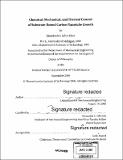Chemical, mechanical, and thermal control of substrate-bound carbon nanotube growth
Author(s)
Hart, Anastasios John, 1979-
DownloadFull printable version (69.20Mb)
Other Contributors
Massachusetts Institute of Technology. Dept. of Mechanical Engineering.
Advisor
Alexander H. Slocum.
Terms of use
Metadata
Show full item recordAbstract
Carbon nanotubes (CNTs) are long molecules having exceptional properties, including several times the strength of steel piano wire at one fourth the density, at least five times the thermal conductivity of pure copper, and high electrical conductivity and current-carrying capacity. This thesis presents methods of CNT synthesis by atmospheric-pressure thermal chemical vapor deposition (CVD), where effective choice of the catalyst composition and processing conditions enables growth of tangled single-wall CNTs or structures of aligned multi-wall CNTs, on bare silicon, microstructured silicon, and ceramic fibers. Applying mechanical pressure during growth controls the structure of a CNT film while causing significant defects in the CNTs. This mechanochemisty approach is used to "grow-mold" CNTs into 3D-shaped microforms. A new reactor apparatus featuring a resistively-heated suspended platform enables rapid ( 100 °C/s) temperature control and versatile in situ characterization, including laser measurement of CNT film growth kinetics, and imaging of stress-induced film cracking. By thermally pre-treating the reactant mixture before it reaches the substrate platform, aligned CNTs are grown to 3 mm length in just 15 minutes. (cont.) A microchannel array is created for combinatorial flow studies of nanomaterials growth, having velocity range and resolution far exceeding those of conventional furnaces. A detailed design methodology considers compressible slip flows within the microchannels and flow leaks across the array, and the devices are fabricated by KOH etching of silicon. Initial experiments with this system demonstrate chemically-driven transitions in CNT yield and morphology along the microchannels, and flow-directed alignment of isolated CNTs and CNT strands. Applications of aligned CNTs in reinforced composites and electromechanical probes are enabled by the CNT synthesis technologies presented here, and show significant initial promise through collaborative research projects. Overall, controlling the packing density and matrix reinforcement of aligned CNTs gives material attributes spanning from those of energy-absorbing foams to stiff solids; however, significant increases in CNT length, growth rate, and packing density must be achieved to realize macroscopic fibers and films having the properties of individual CNTs. New machines can be created for studying the limiting aspects of growth reactions, for exploring new reaction regimes, and for producing exceptionally long nanostructures, looking ahead to fabrication of CNT-based materials in a continuous and industrially-scalable fashion.
Description
Thesis (Ph. D.)--Massachusetts Institute of Technology, Dept. of Mechanical Engineering, 2006. Includes bibliographical references (p. 323-357).
Date issued
2006Department
Massachusetts Institute of Technology. Department of Mechanical EngineeringPublisher
Massachusetts Institute of Technology
Keywords
Mechanical Engineering.